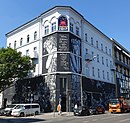Bülowstrasse
| Bülowstrasse | |
|---|---|
| Street in Berlin | |
| Bülowstrasse with the high station of the same name and the Luther Church | |
| Basic data | |
| place | Berlin |
| District | Schöneberg |
| Connecting roads |
Kleiststrasse (west) , Mansteinstrasse (south) |
| Cross streets |
Kulmer Strasse , Alvenslebener Strasse , Dennewitzstrasse , Blumenthalstrasse , Steinmetzstrasse , Potsdamer Strasse , Frobenstrasse , Zietenstrasse |
| Places |
Dennewitzplatz , Nollendorfplatz |
| Buildings | Luther Church |
| use | |
| User groups | Pedestrian traffic , bicycle traffic , car traffic , public transport |
| Technical specifications | |
| Street length | 1100 meters |
The Bülowstraße the Berlin district of Schöneberg is part of the so-called " general campaign ". It was given the name in 1864 in memory of the Wars of Liberation against Napoleon in 1813. It was named after Friedrich Wilhelm Bülow von Dennewitz , Prussian general, who mainly participated in the Battle of Großbeeren on August 23, 1813 and in the Battle of Dennewitz on September 6 Appeared in 1813.
course
The above-ground trunk line (currently: Line U2 ) of the Berlin subway runs along Bülowstrasse . At the intersection with Potsdamer Strasse is the Bülowstrasse high station , which was designed in 1902 in Art Nouveau style by the architect Bruno Möhring . The Dennewitzplatz (also named in honor of Bülow) is located on the Bülowbogen . There the elevated railway line was led through a tenement building; The Academic Beer Halls , a popular beer bar at the time, were located under the passage . During the air raids on Berlin in November 1943 , these buildings were destroyed and most of the remains were later demolished. Below the underground viaduct there is access to an allotment garden colony, which was included in the Westpark in 2013 and provides access for pedestrians and cyclists. The Westpark was opened on May 31, 2013 as the second part of the park at Gleisdreieck .
The southern part of Bülowstrasse is part of a national cycle connection; the connection to the Nelly-Sachs-Park announced for 2008 was not realized until 2014 after many planning deficiencies.
history
The street was laid out in 1862 under the name of Gürtelstraße, and has had its current name since 1864. Following Hobrecht's development plan, it was to merge in a straight line with Hornstraße as part of the general train . However, due to the construction of the track systems for the Potsdamer and Anhalter Bahn, it had to be swiveled south, so it leads in a bend over Dennewitzplatz to Yorckstrasse.
At the beginning of the 20th century, Bülowstrasse was the focal point of the Berlin lesbian and gay scene , there were numerous bars, pubs, cafes and event locations, such as the Dorian Gray , the Nationalhof , the Hohenzollern-Diele , the O-la-la and many others more.

At Bülowstrasse 52 and 54 there are formerly occupied houses that were legalized in 1984. Today they manage themselves. There were other occupied houses at Bülowstrasse 55 ( Berlin's first " Tuntenhaus ") and 89. The house at Bülowstrasse 55 was vacated shortly before Christmas 1984, house number 89 on September 22, 1981 the demonstrators driven into the traffic on Potsdamer Strasse. It was Klaus-Jürgen Rattay by a bus of the BVG captured and killed.
The street became known throughout Germany through the ARD evening series Praxis Bülowbogen with Günter Pfitzmann . With Berlin, Bülowstraße 80a , it is also the eponymous setting of a historical youth novel by Gabriele Beyerlein , which is set in Berlin at the end of the 19th century.
On the north side in the section between Potsdamer Straße and Nollendorfplatz and the adjacent streets there is street prostitution , which is being displaced more and more from Kurfürstenstraße due to construction work.
Urban nation
Bülowstrasse 7 has housed the Urban Nation museum of the Berlin Life Foundation of the municipal housing company Gewobag since September 2017 . The museum is managed by the German-American curator Yasha Young . The four-story building was converted into a museum by 2017 according to the plans of the architects GRAFT . Changing works of art are also shown on the facade and several houses between Nollendorfplatz and Potsdamer Straße were designed by well-known artists. The museum shows regularly changing exhibitions from its collection and houses the Martha Cooper Library. Works by Shepard Fairey , Fintan Magee, Vhils , Herakut , JR , Damien Hirst , 1UP and Lora Zombie were shown in the exhibitions. There are also regular workshops for young people from the north of Schöneberg.
See also
Web links
- Bülowstrasse. In: Street name lexicon of the Luisenstädtischer Bildungsverein (near Kaupert )
Individual evidence
- ↑ Jörn Hasselmann: The new cycle path ends on the sidewalk. In: tagesspiegel.de . August 17, 2007. Retrieved January 19, 2019 .
- ↑ Jörn Hasselmann: Traffic accidents 2014 in Berlin: Speeders are the greatest risk. In: tagesspiegel.de . February 24, 2015, accessed January 19, 2019 .
- ↑ berlin.kauperts.de: Bülowstrasse 1-106 in Berlin - KAUPERTS , accessed on November 11, 2019
- ^ The case of Klaus-Jürgen Rattay , documentation of the rbb with TV interview Benny Härlin
- ↑ Christian Gehrke: There again: The sex practice on the Bülowbogen. In: berliner-kurier.de. June 27, 2017. Retrieved January 19, 2019 .
- ↑ URBAN NATION - Berlin Life Foundation. In: stiftung-berliner-leben.de. Retrieved January 19, 2019 .
- ^ Museum - Urban Nation. In: urban-nation.com. Retrieved January 19, 2019 .
- ↑ URBAN NATION MUSEUM FOR URBAN CONTEMPORARY ART -. In: visitberlin.de. Retrieved January 19, 2019 .
Coordinates: 52 ° 29 ′ 39 ″ N , 13 ° 22 ′ 3 ″ E




